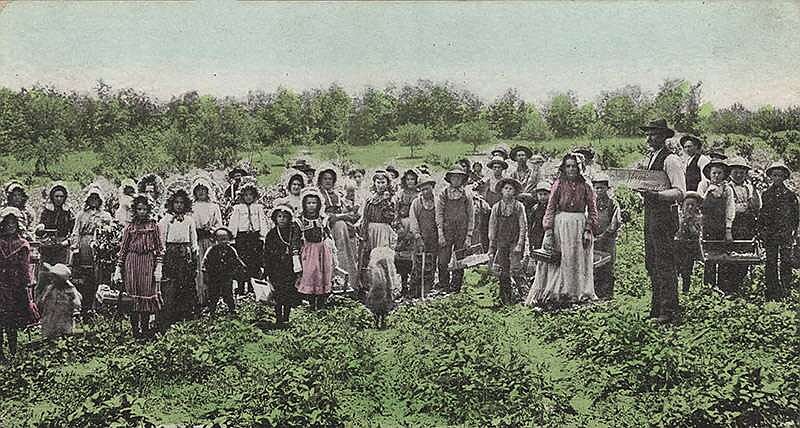Growing strawberries on a large scale in Arkansas began in the late 19th and early 20th centuries when the advent of railroads made possible the profitable shipping of the fruit.
Previously, a two- or three-day trip by mule cart or oxen would result in a load of moldy fruit. Only when the growing regions in the fertile river valleys were reached by the railroad, especially those with fast service and refrigerated cars, were growers able to ship from remote towns to larger cities with little loss. From that time on, strawberries would "kick off" the growing season. By the time strawberry plants have stopped producing, other fruits and vegetables are ready to be taken to market, thus allowing a savvy grower to stagger crops throughout the summer and into fall.
Daniel W. Wheaton is credited with planting the first successful strawberry crop in White County. Other area farmers quickly imitated his success. Jacob C. Bauer started the Bauer Plant Co., which grew and sold strawberry plants. Louis Hubach developed new varieties of stronger plants with better fruit. The industry enjoyed a peak year in 1921, suffered setbacks due to plant disease in 1922 and 1923, then continued to grow and prosper even during the years of the Great Depression. Lack of farm labor and the inability to mechanize berry picking, however, led to a lessening of the strawberry's importance after World War II.
The locations where strawberries could be profitably grown were limited because the berry business needed railroads, level land for fields, non-rocky soil, plenty of water for irrigation (without the land being swampy), and a moderate climate with late frosts and freezing. The strip of land that follows present-day U.S. 67/167 from Jacksonville to Newport was the major location for growing strawberries, especially in such towns as McRae and Bald Knob. A second major site was the Arkansas River Valley from Conway to Van Buren.
White County is fairly representative of strawberry production in Arkansas in the early 20th century. In the early 1900s, a McRae box factory's entire output was used for the shipping of strawberries, and strawberry production constituted the largest economic activity in the town, even when compared to cotton and timber operations. The McRae Strawberry Association was created in 1912. Other towns such as Judsonia, Bald Knob, Searcy and Beebe were also major sites of production, complete with warehouses and canneries. In 1938, county agents in Searcy County organized the Flintrock Strawberry Growers Association to help growers in obtaining supplies and marketing. The flintrock ridges of eastern Searcy County became a major strawberry growing area, peaking in the mid-1950s.
Some modern agricultural methods that have helped strawberry growers are plasticulture, fertilizer, pesticides and genetic improvement of plants. Probably the most important innovation regarding strawberry farming is plasticulture, a farming technique whereby tens of thousands of young strawberry plants or "plugs" per acre are planted in raised beds that have been covered with heavy plastic. Before young strawberry plants are put in the ground, the soil is prepared by fumigation with methyl bromide and chloropicrin. This pesticide combination kills soil nematodes, diseases, insects and weeds. Although it does not remain in the plant or soil, many countries have banned methyl bromide's use due to its effect on the earth's ozone layer. However, Congress was heavily lobbied by the chemical industry, with the result that methyl bromide's use is not banned but is limited to certain agricultural industries, including strawberries.
The railroad led to the emergence of Arkansas' strawberry industry, but other innovations in transportation -- such as the shipping of berries via refrigerated truck -- actually led to its decline, especially as it became possible to ship berries from areas of the country more suitable to the cultivation of strawberries. For berries to grow to be their sweetest, the weather has to be warm and sunny. Cold and rainy weather produces inferior berries. The state of California, which ranks first in the nation in strawberry production, possesses an environment that allows production to go on throughout the year. Florida cultivators can raise and pick their berries for six months of the year. By contrast, the strawberry season in Arkansas consists of only about six weeks.
So, by the 1950s, strawberry cultivation in Arkansas declined in the face of the competition from other states. However, a number of growers continued to cultivate strawberries, especially for the local market and for farmers markets; noteworthy farms are located in Cabot, Judsonia and Clarksville. While Arkansas in the 21st century produces very little of the nation's strawberry crop, their appearance at farmers markets throughout the state often leads to a scramble for the precious berries by those who prefer the robust sweetness often lacking in fruit shipped from across the country. -- Deborah Moore
This story is adapted by Guy Lancaster from the online Encyclopedia of Arkansas, a project of the Central Arkansas Library System. Visit the site at encyclopediaofarkansas.net.
